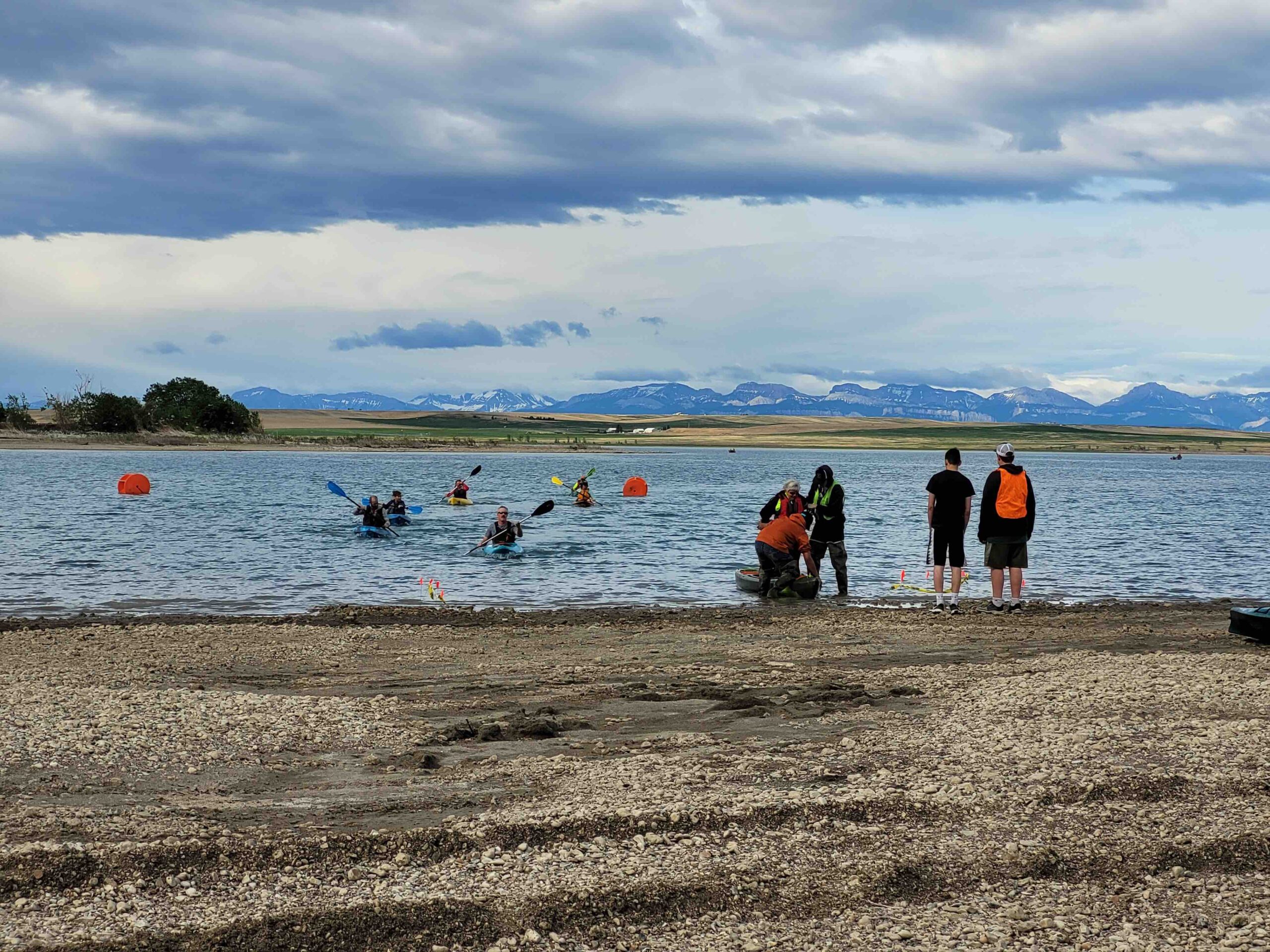Ask the EPA to deny an injection well permit that threatens wildlife, clean water, and rural livelihoods in Pondera County
The Environmental Protection Agency is poised to permit the injection of industrial wastewater generated from the production of aviation biofuels into the Madison Aquifer at two former oil and gas wells located close to Dupuyer Creek in Pondera County. Although The EPA claims the injections will not endanger local water supplies due to the depth of the wells and intervening geology, the Pondera County Commissioners and many local residents oppose the proposed plan due to the lack of disclosure of the wastewater content, potential for contamination of ground and surface water, the impact of frequent heavy truck traffic on rural roads and public safety, or the potential for grizzly bears and piping plover to be killed or displaced, both of which are Threatened species protected by the Endangered Species Act.
GTMA shares these concerns and encourages anyone who does too or would like to learn more to attend a public hearing on the proposed Class V permit on Wednesday, April 3rd at Conrad High School. The EPA needs to see the level of concern in the community. GTMA encourages you to provide verbal comment at the meeting or written comment about your concerns.
Protect clean water, wildlife, and rural livelihoods in Pondera County!

Attend the Public Meeting Wednesday, April 3
The EPA will host an information session from 5:00 – 6:00 followed by a public hearing from 6:00 – 8:00. Verbal comments accepted. However, please show up even if you have nothing to say as your presence alone signals to the EPA the community concern.
Conrad High School Auditorium
308 S Illinois Street
Conrad, MT 59425
Submit Written Comment
Comments are due Monday, April 8th, 2024
Comments can only be submitted via email to:
Lozano.velrey@epa.gov, Subject: MOGO Jody Field comments
Suggested Talking Points Below
Access Information About the Permit
Information about the permit as well as the EPA’s underground injection control program can be found here on the EPA’s website.
Why This Matters
Clean water is one of our most precious resources and must be protected. This industrial wastewater injection scheme puts surface and groundwater at risk. Lake Francis, a key water source for wildlife, recreation, and hundreds of farmers is only a few miles from the injection site. The incessant, heavy truck traffic required to deliver the water will run 7 days a week, 365 days a year, causing damage to roads, increased public safety risks, and likely mortality to grizzly bears, piping plover, and other wildlife.
These two wells are not the only ones slated to receive wastewater. Montalban Oil and Gas, the company which owns the wells, has indicated it has other wells it plans to permit for wastewater injection. Montana Renewables, the aviation biofuel producer, has plans to ramp up production. The rail hub at Shelby would also allow companies in other places to ship their wastewater here for injection underground. Stopping this permit is key to preventing Pondera County from becoming an industrial wastewater dumping ground and to protect the wildlife, water, and people of the area.
Suggested Talking Points
The following talking points are intended to help you get started in sharing your perspective or concern about the proposed permit. The more personalized and substantive your message, the more effective it will be.
- The content of the wastewater needs to be disclosed to the public and local officials. The public has a right to know what is actually in the wastewater. All we know is that it contains by products from renewable feedstocks that include but are not limited to vegetable oils and animal fats. Although Montana Renewables CEO Bruce Fleming claimed publicly the water is so clean you can drink it, the company will not disclose what’s in it, nor release samples for independent testing. A review of lab reports indicates the water is nasty, likely full of heavy metals and other chemicals. Tell the EPA to require disclosure prior to any permit being issued, as well as a commitment to on-going independent sampling.
- Current or future sources of drinking water must be protected. Although no local wells are known to draw from the depth at which the wastewater would be injected, other communities do draw from the Madison aquifer, which extends over a vast area of the western great plains. Spilled wastewater could contaminate surface water. Injected wastewater could find cracks to move upward and contaminate shallower groundwater sources. Earthquakes (Pondera County is rated as “medium risk” for earthquakes) or pressure from the injected wastewater could cause new cracks to form. This scheme is simply not worth the risk to local water sources upon which families, farmers, ranchers, and wildlife depend.
- An emergency response plan and monitoring plan are needed. None of the company’s involved have provided a meaningful emergency response plan to manage spills or accidents. No groundwater or surface water monitoring to detect contamination is currently proposed or required. Nor is any bonding required by the companies to cover future clean-up costs should that be necessary. This all needs to be corrected before any permit is issued.
- The EPA must prevent harm from this project to grizzly bears. Grizzly bears frequent the high-quality habitat along the creek near the well. The heavy truck traffic could hit and kill grizzly bears or cause them to avoid the area. Grizzlies could be attracted to animal fats in spilled wastewater or human food and garbage left by workers, leading to management removals if conflicts occur. By law, the EPA must consult with the US Fish and Wildlife Service about how to prevent harm to grizzly bears, something they do not appear to have done.
- The EPA must prevent harm from this project to piping plovers. The wells are also in the vicinity of the only breeding habitat for Piping Plover along the Rocky Mountain Front. Piping plovers could be killed by trucks or wastewater spills could damage their breeding habitat. The EPA must consult with the US Fish and Wildlife Service about potential harms like these, and how to mitigate them, before issuing a permit, which they do not appear to have yet done.
- Potential for additional wells to be permitted and the cumulative impacts of additional injection wells in the area, need to be disclosed and assessed. Montalban Oil and Gas Operations owns numerous old oil and gas wells in the area that could potentially be converted into injection wells for industrial wastewater in the future. By law, the EPA needs to consider this foreseeable possibility and assess the cumulative impacts on the aquifer, wildlife, and local communities this would create.
- Unacceptable impacts to county roads and public safety a must. Pondera County is rightfully concerned about increased maintenance cost to grade, maintain, and plow the county roads the heavy truck traffic will traverse, as well as potential increased public safety incidents like motor vehicle collisions. Best available estimates is several dozen trips per day, every day of the year. The project provides no revenue to Pondera County.
- Montana Renewables should build a treatment facility instead. Montana Renewables has said the wells are a temporary measure until it can build a treatment facility; yet it has not disclosed any actual plans to do so. Montana Renewables should expedite the construction of a treatment facility rather than inject industrial wastewater underground. Treating the wastewater would reduce the environmental impact and improve the true sustainability of their aviation biofuels.
More Information
Montalban Oil and Gas has requested the EPA convert its current Class II permit for two wells near Dupuyer Creek to a Class V permit so Montana Renewables can inject industrial wastewater generated by the production of aviation biofuel. Montana Renewables produces aviation biofuels at its plant in Great Falls using vegetable and animal feedstocks sourced mostly from Canada. It sells the biofuel to Delta and other major airlines as a “renewable energy.” The production process generates an estimated 126,000 gallons of industrial wastewater daily. The City of Great Falls refuses to accept the water at its treatment facility due to its level of contamination. Montana Renewables has refused to release a list of contaminants citing proprietary information, and requests by Pondera County for samples to conduct independent tests have been repeatedly denied. The wastewater is currently trucked to Shelby and railed to the Midwest, where it is injected underground. Montana Renewables says the injections would be temporary while it builds a pre-treatment facility. However, it has not released any specific plans to do so.
The Cut Bank Pioneer Press and Montana Free Press have provided some good coverage of the proposed permits, as well as public and Pondera County Commissioner concerns with the project.
ProPublica conducted extensive investigative reporting about how shortcomings in the EPA’s regulation and oversight of similar injection wells contributed to pollution of our underground drinking water elsewhere in the country.
You can learn more about Piping Plover in Montana from the Montana Natural Heritage Program website or the US Fish and Wildlife Service.
You can read about the EPA’s underground injection control program here on their website.
Grizzly bears, which historically ranged in the tens of thousands throughout the northern Rockies and the West, including all of Montana, were largely extirpated after colonization. By 1975, when grizzly bears were listed as a threatened species, only small populations survived in isolated, mountainous parts of Montana, Idaho, Wyoming, Washington, and Colorado. Current estimates for the Northern Continental Divide Ecosystem population – the largest and most secure of the four remaining grizzly bear populations – suggest approximately 1,100 bears in the region. While this is up significantly from an estimated population of 300 in 1986, population growth has been fairly stagnant for the past decade even as bears have expanded their range, according to biological data from the USFWS and state of Montana.
The Status Review comes at a particularly fraught time for grizzly bear recovery. Despite progress in recent decades, most, if not all, grizzly bear populations still have not met scientific and legal criteria for delisting. The bear's future in our region is far from secure, due to mounting pressures from explosive development in western Montana, increased recreational use of public lands, transportation infrastructure and climate change, to name a few. Grizzly bears have also come under increasing attack from Montana politicians who want to see wildlife managers take a more lethal, rather than scientific and precautionary, approach to managing these animals.
The future of Grizzly bears is still not secure enough to warrant delisting.
